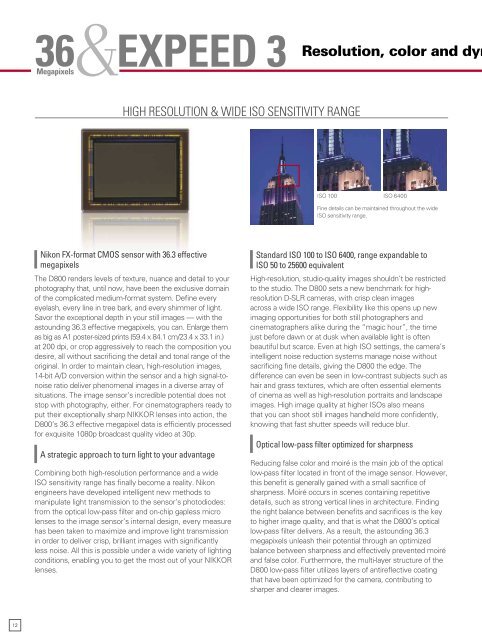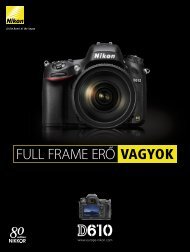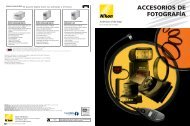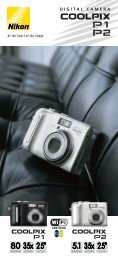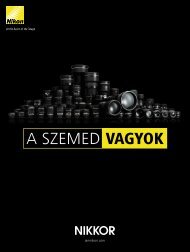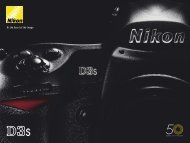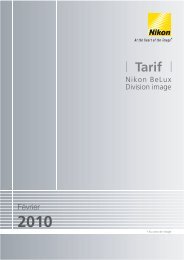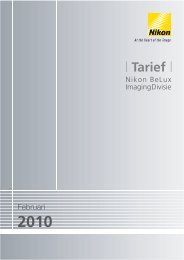Nikon D800
Nikon D800
Nikon D800
You also want an ePaper? Increase the reach of your titles
YUMPU automatically turns print PDFs into web optimized ePapers that Google loves.
36&EXPEED<br />
3<br />
Megapixels<br />
The <strong>D800</strong> renders levels of texture, nuance and detail to your<br />
photography that, until now, have been the exclusive domain<br />
of the complicated medium-format system. Define every<br />
eyelash, every line in tree bark, and every shimmer of light.<br />
Savor the exceptional depth in your still images — with the<br />
astounding 36.3 effective megapixels, you can. Enlarge them<br />
as big as A1 poster-sized prints (59.4 x 84.1 cm/23.4 x 33.1 in.)<br />
at 200 dpi, or crop aggressively to reach the composition you<br />
desire, all without sacrificing the detail and tonal range of the<br />
original. In order to maintain clean, high-resolution images,<br />
14-bit A/D conversion within the sensor and a high signal-tonoise<br />
ratio deliver phenomenal images in a diverse array of<br />
situations. The image sensor’s incredible potential does not<br />
stop with photography, either. For cinematographers ready to<br />
put their exceptionally sharp NIKKOR lenses into action, the<br />
<strong>D800</strong>’s 36.3 effective megapixel data is efficiently processed<br />
for exquisite 1080p broadcast quality video at 30p.<br />
Combining both high-resolution performance and a wide<br />
ISO sensitivity range has finally become a reality. <strong>Nikon</strong><br />
engineers have developed intelligent new methods to<br />
manipulate light transmission to the sensor’s photodiodes:<br />
from the optical low-pass filter and on-chip gapless micro<br />
lenses to the image sensor’s internal design, every measure<br />
has been taken to maximize and improve light transmission<br />
in order to deliver crisp, brilliant images with significantly<br />
less noise. All this is possible under a wide variety of lighting<br />
conditions, enabling you to get the most out of your NIKKOR<br />
lenses.<br />
Resolution, color and dynamic range: the perfect trinity<br />
HIGH RESOLUTION & WIDE ISO SENSITIVITY RANGE HIGH IMAGE QUALITY & IMAGE-PROCESSING SPEED<br />
<strong>Nikon</strong> FX-format CMOS sensor with 36.3 effective<br />
megapixels<br />
A strategic approach to turn light to your advantage<br />
ISO 100 ISO 6400<br />
Fine details can be maintained throughout the wide<br />
ISO sensitivity range.<br />
Standard ISO 100 to ISO 6400, range expandable to<br />
ISO 50 to 25600 equivalent<br />
High-resolution, studio-quality images shouldn’t be restricted<br />
to the studio. The <strong>D800</strong> sets a new benchmark for highresolution<br />
D-SLR cameras, with crisp clean images<br />
across a wide ISO range. Flexibility like this opens up new<br />
imaging opportunities for both still photographers and<br />
cinematographers alike during the “magic hour”, the time<br />
just before dawn or at dusk when available light is often<br />
beautiful but scarce. Even at high ISO settings, the camera’s<br />
intelligent noise reduction systems manage noise without<br />
sacrificing fine details, giving the <strong>D800</strong> the edge. The<br />
difference can even be seen in low-contrast subjects such as<br />
hair and grass textures, which are often essential elements<br />
of cinema as well as high-resolution portraits and landscape<br />
images. High image quality at higher ISOs also means<br />
that you can shoot still images handheld more confidently,<br />
knowing that fast shutter speeds will reduce blur.<br />
Optical low-pass filter optimized for sharpness<br />
Reducing false color and moiré is the main job of the optical<br />
low-pass filter located in front of the image sensor. However,<br />
this benefit is generally gained with a small sacrifice of<br />
sharpness. Moiré occurs in scenes containing repetitive<br />
details, such as strong vertical lines in architecture. Finding<br />
the right balance between benefits and sacrifices is the key<br />
to higher image quality, and that is what the <strong>D800</strong>’s optical<br />
low-pass filter delivers. As a result, the astounding 36.3<br />
megapixels unleash their potential through an optimized<br />
balance between sharpness and effectively prevented moiré<br />
and false color. Furthermore, the multi-layer structure of the<br />
<strong>D800</strong> low-pass filter utilizes layers of antireflective coating<br />
that have been optimized for the camera, contributing to<br />
sharper and clearer images.<br />
EXPEED 3 image-processing engine: speed, versatility,<br />
and high performance<br />
High-megapixel still images are detail-rich<br />
but data-heavy. With the <strong>D800</strong>, however,<br />
you don’t have to sacrifice speed for this<br />
privilege. Dedicated to understanding<br />
speed and its role in image making, <strong>Nikon</strong><br />
engineers designed a powerful EXPEED 3<br />
image-processing engine exclusively for<br />
digital SLRs. From image processing and<br />
card recording to image playback and<br />
image transfer, EXPEED 3 manages massive amounts of<br />
data at faster speeds than EXPEED 2. Even with specialized<br />
processing features like Active D-Lighting and high ISO noise<br />
reduction, capture speed is not affected. EXPEED 3 is so<br />
powerful that it handles data-intensive tasks such as Full<br />
HD video recording at 30p with ease. You’ll also notice the<br />
difference in your still images and videos through minimized<br />
noise and even richer colors and tones. In addition to these<br />
fundamental advantages, the <strong>D800</strong> reduces the kind of<br />
color phase shift that some cameras have difficulty with in<br />
similar situations.<br />
Lateral chromatic aberration reduction: Take full<br />
advantage of your NIKKOR lens collection<br />
High-megapixel sensors can really test the quality of your<br />
lenses, but you can be confident that the combination of<br />
brilliant NIKKOR lenses and <strong>Nikon</strong>’s intelligent processing<br />
measures will significantly reduce lateral chromatic<br />
aberration to give you incredibly natural-looking results.<br />
Unlike other correction methods that simply eliminate<br />
chromatic aberration, <strong>Nikon</strong>’s method compensates for these<br />
color differences resolving, making it particularly effective in<br />
producing images with stunning edge-to-edge sharpness.<br />
Moreover, because these corrections are made regardless of<br />
the NIKKOR lens used, this feature contributes substantially<br />
to achieving the sharpest images possible.<br />
Rich tones and natural colors thanks to the EXPEED 3 image-processing engine.<br />
• Lens: AF-S NIKKOR 24-70mm f/2.8G ED • Exposure: [A] mode, 6 second, f/8 • White balance: Auto 1<br />
• Sensitivity: ISO 100 • Picture Control: Standard<br />
©Jim Brandenburg<br />
14-bit A/D conversion and 16-bit image processing for<br />
rich tones and natural colors<br />
Tonal gradation is where an image transforms from simply<br />
representing life to taking on a life of its own. The <strong>D800</strong> does<br />
exactly that, with cutting-edge image processing that injects<br />
vital energy into your images. Black is rendered as pitch<br />
black, and shadow details are subtle and rich. Even under<br />
harsh, high-contrast light, where some cameras can fail, the<br />
<strong>D800</strong>’s gradation remains smooth with abundant detail and<br />
tone all the way up the scale to pure white.<br />
12 13<br />
With<br />
Without<br />
Lateral chromatic aberration reduction<br />
©Benjamin Antony Monn


